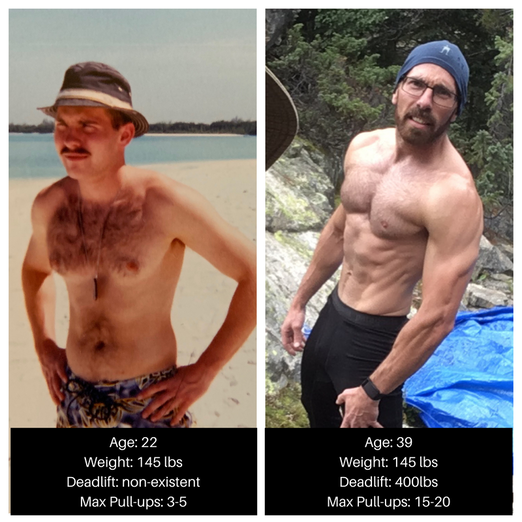 By Ryan Humphries Co-Founder: Axistence Athletics You have goals. Maybe they include increasing your lung capacity so its easier to hike or ski at altitude, or maybe they involve getting strong enough to pull yourself up and over the side of a cliff. Maybe they have to do with losing weight, gaining muscle, or perhaps just looking better naked 😉 A wise man once said, "If yer not trackin', yer slackin". However, the problem that most people have when it comes to tracking is that they only have one tool: The scale... And sure, the scale is great if you have more than 20lbs that you want to lose. It’s also great if you’re trying to put on mass. But looking at the scale every day, or even every week can get pretty demoralizing if you’re not seeing changes. My recommendation? Please step away from the scale... The scale isn’t inherently a bad tool, it's just not the ONLY tool you should be using to measure your progress. If you want to LOOK strong, guess what...You have to BE strong. No one rides the GAINZ train for free. If and when you arrive at where you want to be physically, you’re not going to need an electronic device to let you know you’re there. You’ll know it because you’ll FEEL it. You'll SEE it. Your friends and family will start to ask you what you’ve been doing differently. Your peak physique isn't a number on a device. It's how you look, feel and perform as a result of smart, consistent training. "I’ve seen far too many humans chase the numbers on the electronic devices, only to hit those numbers and STILL be disappointed because they didn't look like they thought they would." For shits and giggles, let’s say that you ARE working out consistently, and that you ARE tracking at least something. However, you’re not FEELING or SEEING results... It could be time for a shift in either how you're training or how you're tracking. Personally, when working with clients, I like to assign benchmarks. A benchmark could be anything from a 50 bpm metronome push-up test, to a one mile run, to a specific standardized workout that we can objectively measure. I also like to give them something to shoot for. We do the same with the Axistence programming. Every 8 weeks we test and re-test specifically for this purpose. Ultimately, how you choose to train is up to you, but we HIGHLY encourage people to test themselves in order to get a baseline, and then re-test to see if they’ve improved. Of course, everyone is going to have different goals, but for many people, the benchmarks are pretty similar. Let’s take pull-ups as an example. Regardless of your goal, if you can perform a pull-up today, and 8 weeks ago you couldn’t, chances are that your arms and back are starting to look different as well. For cardio, if it used to take you 12 minutes to run a mile and now it takes you only 8, chances are that you're seeing body composition changes as well. And you know what? All of that may have happened without moving the numbers on the scale. Don't believe me? In the pic on the left below I was 22 years old. I don't know for sure, but I'd guess I was around 15ish percent body fat. I didn't use barbells, kettlebells, or anything really. I ran a little, smoked a little, and drank a lot :). On the pick on the right, I had been doing real strength training for about 10 years, but no more than 3-4x per week. I was about 12-15% body fat percent when the pic on the right was taken. The weight is the same, the body fat damn near the same. The difference? In one of these pics I was actually strong! (side note, I don't drink like a sailor anymore, but I still enjoy an adult beverage or three) Having an ideal body weight or body composition is great....but it still might not actually be what you’re looking for. I’ve seen far too many humans chase the numbers on the electronic devices, only to hit those numbers and STILL be disappointed because they didn't look like they thought they would. Why? Because they hadn’t actually developed the real-world fitness to go along with those numbers.
A tale of two fitness levels: Example A. A 35-year-old human weighing 140 lbs and 20% body-fat. They possesses the ability to do 0 push-ups and they're nowhere near being able to do a pull-up yet. They worry that barbells might make them "bulky". However, they can run slowly for 10+ miles without getting tired. Example B. A 35-year old human weighing 140 lbs and 20% body-fat. They possess the ability to do 20 push-ups and at least 5 pull-ups. They can deadlift 1.5x their own bodyweight with excellent form. They run when they want to, and not for long distances. One of these humans will have more of a “toned” look and one of them may look more “skinny fat”. I’ll let you figure out which is which... If we seek out reasonable yet challenging standards and test ourselves regularly, we won’t need the scale to tell us when we've achieved our goal. This leads us into the often asked question: "So what should I test?" Well, it just so happens that we have quite the collection of tests that we’ve gathered over the years 😊. *Disclaimer* Not every human needs to test themselves with every movement listed. However, excluding injuries and mobility limitations, I do beleive most adventure athletes who want to get stronger should get curious as to where they stand with the following: If you'd like to view a comprehensive list of the skills/movements/standards that we use with our athletes, please check out the next post: Measurements and Movement Standards
0 Comments
Your comment will be posted after it is approved.
Leave a Reply. |
Our JournalOur coaches research and report on all things regarding fitness, adventure and the community within. Categories
All
|
Located in SE Denver1950 S. Quebec St.
Denver, CO 80231 Looking for a gym near Denver? We also serve Glendale, Aurora, Lowry, Virginia Village, Denver Tech Center, Cherry Creek, Indian Creek, Wash Park, Broadway, SOBO, and more.
|
|


 RSS Feed
RSS Feed





